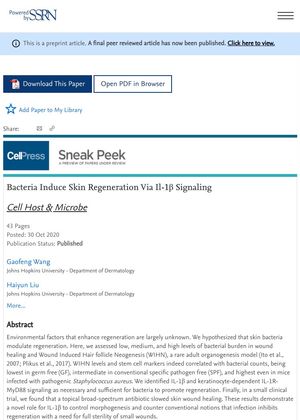Bacteria Induce Skin Regeneration Via IL-1β Signaling
January 2020
in “
Social Science Research Network
”

TLDR Skin bacteria help in skin regeneration and wound healing, with a specific signal called IL-1β playing a crucial role.
The study conducted by researchers from Johns Hopkins University and the University of Pennsylvania in 2019 found that skin bacteria play a role in skin regeneration and wound-induced hair follicle neogenesis (WIHN). The researchers observed varying levels of bacterial burden in wound healing and WIHN, with the lowest levels in germ-free environments, intermediate levels in specific pathogen-free conditions, and the highest levels in mice infected with pathogenic Staphylococcus aureus. The study identified IL-1β and keratinocyte-dependent IL-1R-MyD88 signaling as necessary for bacteria to promote regeneration. In a small clinical trial, it was found that a topical broad-spectrum antibiotic slowed skin wound healing. This suggests that IL-1β controls morphogenesis and challenges the conventional belief that infection inhibits regeneration and small wounds need to be fully sterile.
